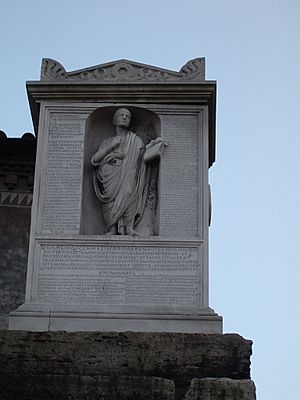Latin poetry facts for kids
Latin poetry is the amazing poetry that came from Ancient Rome. The Romans loved stories and songs, just like we do today. Their poetry often started by taking ideas from Greek poems.
The oldest surviving examples of Latin literature are the funny plays written by a poet named Plautus. He probably wrote these comedies between 205 and 184 BC. Imagine watching a play from over 2,200 years ago!
The Start of Roman Poetry
Roman poetry really began with a Greek slave named Livius Andronicus. In 240 BC, he wrote a play in Rome. Livius was super important because he translated Greek comedies for Roman audiences.
He also used special rhythms, called metres, that were common in Greek drama. But he changed them a bit to fit the Latin language. This helped Romans enjoy Greek stories in their own language.
Famous Early Poets
After Livius, other poets like Plautus and Terence continued his work. They kept adapting Greek styles for Roman tastes.
A poet named Ennius (who lived from 239 to 169 BC) brought a very important rhythm to Latin poetry. This was the dactylic hexameter. It was the main rhythm used in Greek epic poems, which are long stories about heroes.
Ennius's work became a model for later, very famous Roman poets. These include Virgil and Ovid.
Masters of Rhythm
Horace was another great poet who lived around the same time as Virgil. He also wrote verses using the dactylic hexameter. Horace's poems often felt like friendly letters or conversations.
Virgil's use of the hexameter is considered the best in all of Latin literature. His poems flow beautifully and sound very grand.


